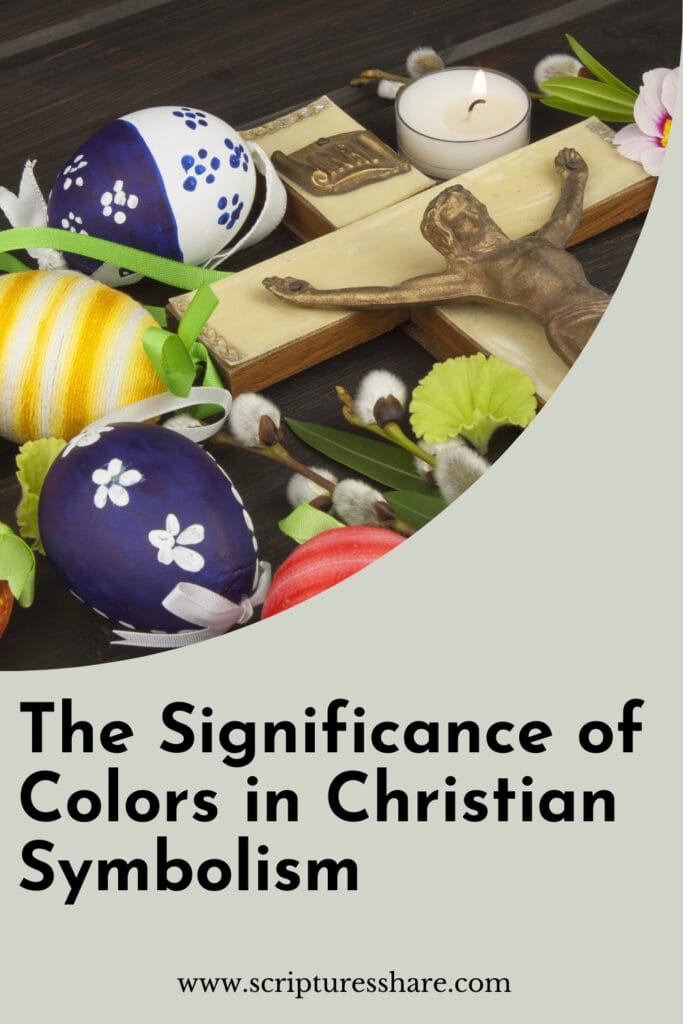No products in the cart.
The Significance of Colors in Christian Symbolism
This post contains paid and/or affiliate links. I make a small commission at no extra cost to you. Please see our Privacy Policy.
Colors in the Bible hold profound meanings in Christian symbolism, revealing important concepts and themes in Scripture. Understanding the significance of these colors can deepen our understanding of the faith and provide insight into the messages conveyed in the Bible. What do the Colors in Christian Symbolism mean to you?
The Significance of Primary Colors in the Bible
The three primary colors found in nature, red, blue, and yellow, hold particular significance in the Bible.
Red: In the Bible, red symbolizes humanity and carries deep spiritual meaning. It is associated with the blood sacrifices of the Old Testament, illustrating the need for atonement and the blood of Jesus shed for the salvation of mankind.
Blue: Another primary color with biblical significance is blue. It represents the heavens and is often connected to the Word of God. In Scripture, blue is used to symbolize divine revelation, spirituality, and the presence of God.
Yellow: Yellow is associated with gold and represents God’s sovereignty and presence. It is a vibrant color that signifies His glory, majesty, and divine authority. The golden hue of yellow is often used to describe heavenly glory and is a reminder of His eternal reign.

The Significance of Secondary Colors in the Bible
Secondary colors in the Bible carry symbolic meanings that add depth to the understanding of Scripture. Let’s explore the significance of three secondary colors: green, amber, and purple.
Green
Green represents life, restoration, and new beginnings in the Bible. It is associated with the flourishing of nature and the vitality of creation. Green also symbolizes resurrection, reflecting the eternal life and hope found in Christ.
Amber
Amber symbolizes God’s glory, judgment, and endurance. It is often referred to as “burnished bronze” in the Bible and points to God’s divine presence and sovereignty. It also reminds us of His righteous judgment and the endurance required of His people.
Purple
Purple is a color associated with royalty, majesty, and priesthood in the Bible. It represents the kingship and divinity of Jesus Christ. Purple dye was costly and symbolized wealth and status in ancient times, making it a fitting color for the King of Kings.
Understanding the symbolism behind these secondary colors adds another layer of meaning to biblical narratives and teachings. It allows us to appreciate the intricate details and messages conveyed through colors in the Bible.
Additional Colors in Christian Symbolism
Colors have deep symbolic significance in Christian symbolism, with each color representing different aspects of faith and spirituality. In addition to the primary and secondary colors, other colors mentioned in the Bible hold significant meaning.
White in the Bible
White represents holiness, light, purity, and the righteousness of Jesus Christ. It signifies spiritual cleanliness and redemption, as well as the divine presence of God. The color white is often associated with heavenly beings and is a symbol of salvation and eternal life.
Black in the Bible
Black symbolizes sin, darkness, death, and catastrophe. It reflects the fallen nature of humanity and the need for redemption. While black is often associated with negative connotations, it also serves as a contrast to highlight the power of God’s grace and love.
Silver in the Bible
Silver symbolizes the Word of God, divinity, salvation, and refinement. It represents the purity and perfection of God’s truth. Silver is often associated with wisdom, wealth, and the value of spiritual treasures.
Scarlet in the Bible
Scarlet can represent both sin and royalty. It signifies the depth and intensity of sin and the need for atonement. Scarlet is also associated with the blood of Jesus, symbolizing His sacrifice and the redemption that comes through His death.
Bronze in the Bible
Bronze symbolizes strength and durability. It represents God’s power and protection, as well as His faithfulness and steadfastness. Bronze is often associated with craftsmanship and divine providence.
- White: Holiness, light, purity, redemption.
- Black: Sin, darkness, death, catastrophe.
- Silver: Word of God, divinity, salvation, refinement.
- Scarlet: Sin, royalty, atonement.
- Bronze: Strength, durability, divine providence.
The Most Vivid Representation of Colors in the Bible
The Bible’s most vivid representation of colors is found in the rainbow mentioned in Genesis 9:13.
The rainbow symbolizes God’s covenant with humanity and His promise never to destroy mankind with a flood again.
It emphasizes the beauty and diversity of colors that God has created.
The Relevance of Color Representation for Christians Today
In modern Christianity, the use of colors holds significant meaning and symbolism, representing various facets of God’s character and promises. These vibrant hues are incorporated into Christian practices and traditions, conveying deeper spiritual messages to believers and enhancing their worship experiences.
- Red and Gold: During the Christmas season, red and gold are prominently featured, symbolizing the birth of Jesus and the coming of the King. Red represents His sacrificial love and the blood He shed for humanity’s salvation, while gold represents His divine majesty and kingship.
- Green: In celebrating Spring and Jesus’ resurrection, green is the color of new life and restoration. It reminds Christians of the hope and promise of eternal life through Jesus‘ victory over death.
- White: Symbolizing purity and righteousness, white is often associated with baptism and rebirth. It represents the forgiveness of sins and the cleansing power of Jesus, enabling believers to start anew in their spiritual journey.
Additionally, the rainbow holds significant meaning in Christian symbolism and is widely recognized as a symbol of Christianity. It represents God’s covenant with humanity and His promise never again to destroy the world with a flood. The rainbow is a beautiful reminder of God’s faithfulness, love, and grace.
In Christian merchandising and marketing, the symbolism of colors is often utilized to create visual representations of faith. Christian artwork, products, and branding incorporate vibrant colors to evoke emotions, capture attention, and communicate the various aspects of Christian belief to a broader audience.
By embracing color symbolism in modern Christianity, believers can deepen their connection to God’s Word, express their faith visually, and foster a greater appreciation for the richness of Christian traditions.
Exploring Colors in Early Christian Art
Early Christian art embraced using colors as a powerful tool for conveying symbolism and meaning. Throughout this period, artists carefully selected colors to communicate Christian themes and messages in visual form effectively.
- Blue: Often used to represent heaven, blue evoked a sense of the divine and the spiritual realm.
- Red: Red hues were employed to depict action, imparting a sense of spiritual awakening and the enthusiasm of faith.
- White: Symbolizing purity and innocence, white colors were utilized to portray the divine, angels, and representations of holiness.
- Gold: Gold, frequently incorporated as leaf or paint, was employed to signify the divine nature, illuminating sacred figures and objects with its radiant presence.
Early Christian artists crafted powerful and evocative visual compositions with these intentional color choices, enhancing their religious narratives and inviting viewers to connect with the sacred.
Conclusion
The significance of colors in Christian symbolism is undeniable. Colors deepen our understanding of Scripture and serve as powerful tools for expressing divine truths. Each color has unique symbolism, representing different aspects of God’s character and promises.
Throughout the biblical text and in art, colors continue to hold profound meaning in the Christian faith. Red symbolizes humanity and the sacrifice of Jesus. Blue represents the heavens and the Word of God. Yellow symbolizes the sovereignty and presence of God. Green signifies life and resurrection. Amber represents God’s glory and judgment. Purple symbolizes royalty and the divinity of Jesus.
Other colors, such as white, black, silver, scarlet, and bronze, all carry their symbolic significance, representing various aspects of faith, righteousness, sin, refinement, and strength. The rainbow, mentioned in Genesis, serves as a vivid representation of colors in the Bible, symbolizing God’s covenant and His promise never to destroy mankind with a flood again.
In modern Christianity, colors still represent different facets of God’s character and promises. Whether in practices like Christmas celebrations or Christian merchandising and marketing, colors are crucial in conveying deep spiritual meaning. Early Christian art also employed colors to communicate Christian themes and messages effectively.
FAQ
What is the significance of colors in Christian symbolism?
Colors hold profound meanings in Christian symbolism, reflecting important concepts and themes in Scripture. Understanding the significance of colors can deepen our understanding of the faith and provide insight into the messages conveyed in the Bible.
Which primary colors hold significance in the Bible?
The three primary colors found in nature, red, blue, and yellow, hold particular significance in the Bible. Red symbolizes humanity and is associated with both the blood sacrifices of the Old Testament and the blood of Jesus shed for the salvation of mankind. Blue represents the heavens and is connected to the Word of God, while yellow is associated with gold and symbolizes the sovereignty and presence of God.
What do the secondary colors symbolize in the Bible?
Secondary colors in the Bible also carry symbolic meanings. Green represents life, restoration, new beginnings, and resurrection. Amber symbolizes God’s glory, judgment, and endurance. Purple is associated with royalty, majesty, and priesthood, representing the kingship and divinity of Jesus.
What symbolic significance do other colors hold in Christian symbolism?
Other colors have symbolic significance in Christian symbolism. White represents holiness, light, purity, redemption, and the righteousness of Jesus Christ. Black symbolizes sin, darkness, death, and catastrophe. Silver symbolizes the Word of God, divinity, salvation, and refinement. Scarlet can represent both sin and royalty. Bronze symbolizes strength and durability.
How is the rainbow represented in the Bible?
The most vivid representation of colors in the Bible is the rainbow mentioned in Genesis 9:13. The rainbow symbolizes God’s covenant with humanity and His promise never to destroy mankind with a flood again. It emphasizes the beauty and diversity of colors that God has created.
How are colors relevant in modern Christianity?
In modern Christianity, colors still represent various facets of God’s character and promises. For example, red and gold are associated with Christmas, green with Spring and the resurrection of Jesus, and white with baptism and rebirth. The rainbow is also widely recognized as a symbol of Christianity and is often used in Christian merchandising and marketing.
How were colors utilized in early Christian art?
Early Christian art also utilized colors to convey symbolism and meaning. Artists often used blue to represent heaven, red to depict action or spiritual awakenings, white for purity, and gold to signify the divine. These color choices helped effectively communicate Christian themes and messages visually.













